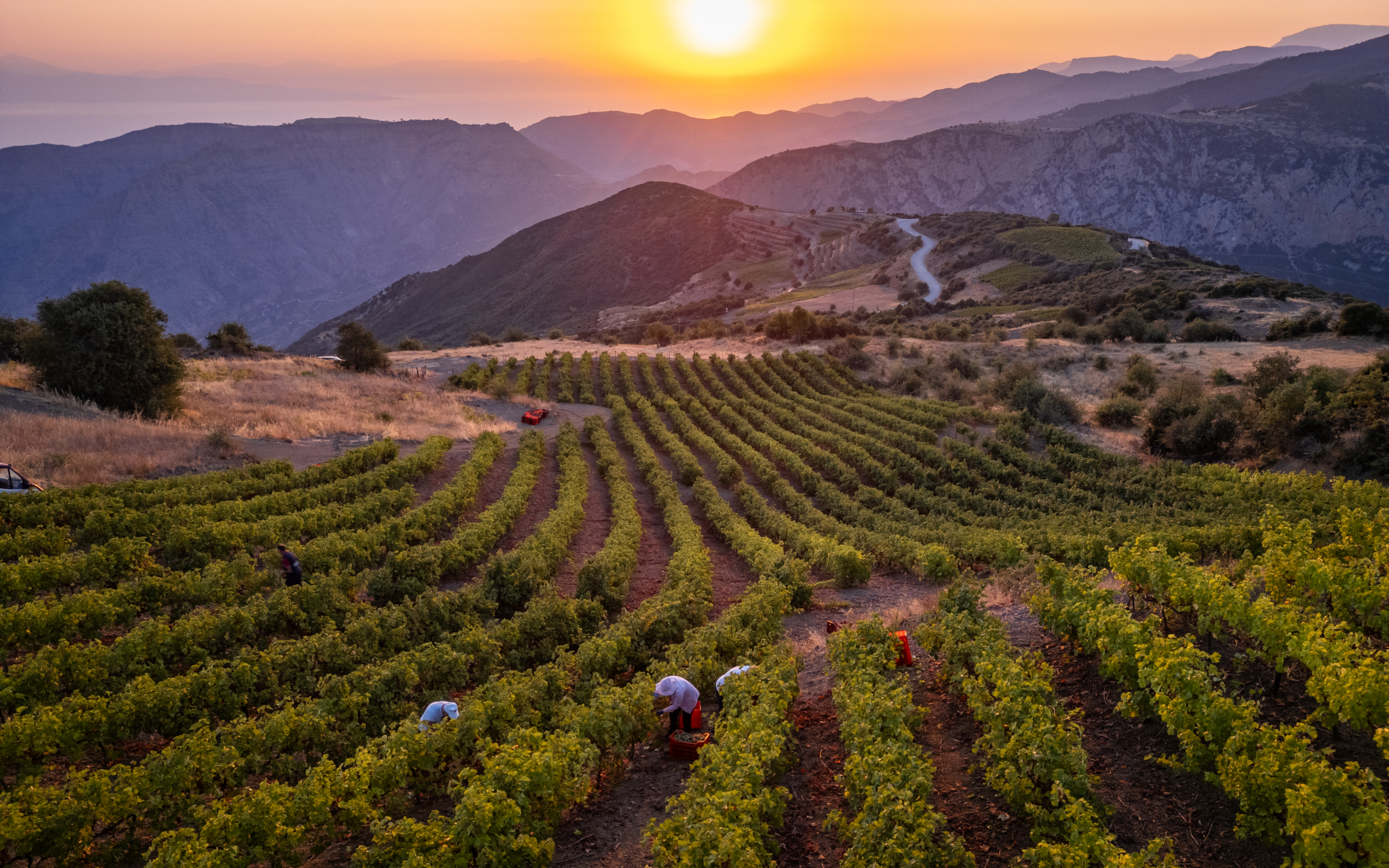
The weather conditions in 2024 confirmed the experts’ predictions. Mild winter, extreme drought and subsequent dry spells, rising average temperatures and prolonged heat waves in summer. Every year, climate change is becoming more pronounced, and this inevitably has an impact on viticulture.
Major wine-producing countries and pioneering wineries have for years been turning to new cultivation methods and the search for vineyards at higher altitudes in order to cope with climate change and its consequences. We have been doing this for 30 years at Rouvalis, in the blessed vineyards of the mountainous Aigialeia. Like the Catalan producer Torres and the Planeta winemakers of southern Italy, we have made a conscious choice for mountainous viticulture, taking advantage of altitudes of up to 1,100 m. We value late autochthonous varieties and innovate by introducing new ones from northern climates, which have found in Aigialeia an ideal terroir to take root and produce unique wines.
The advantage of mountainous vineyards. While in the lowland areas and with the early varieties, the high temperatures cause an unusually early ripening, in the mountainous areas of Aigialeia the ripening this year has been slower and more constant. The harvest was about 20 days earlier at altitudes of 500-650 m, and about 10 days earlier in the more mountainous vineyards (800-1,100 m).
Predominance of late varieties. Unlike most international varieties, which are classified as early ripeners, most of the indigenous varieties of Aigialeia and the Peloponnese in general (Roditis, Mavrodaphne, Kydonitsa) are late ripening varieties, i.e. they need more time to ripen, which makes them more resistant to high temperatures and climate change.
Α recent one-day workshop (organized by Oinoxenia, University of Patras, Western Greece Region) has shown that Mavrodaphne is a top Greek variety in terms of oenology, with good adaptation to the climate crisis and heat stress, and significant advantages compared to other red varieties studied. Similarly, the mountainous Roditis, the main and most late ripening grape variety of Aigialeia, took advantage of the first autumn rains this year and ripened normally, with better results in quantity and quality compared to other varieties.
In general, the production of our vineyards and the cooperating growers in 2024 was quite reduced in quantity, while maintaining high quality and increased aroma intensity. Malic acid, which burns at very high temperatures, was maintained at high levels in mountain vineyards, resulting in pleasing acidity and fine malolactic fermentations.
The harvest in the family-owned vineyards of Rouvalis
Fragosykia Vineyard
Thirty years ago, Angelos Rouvalis replaced the traditional cultivation of black Corinthian raisins in the long-established vineyard of the Rouvalis family, with new wine-making varieties. Today, at Fragosykia, we cultivate the varieties Kydonitsa, Malvasia and Mavrodaphne exploring different ways of making wine. This has led us to our latest creation, a sun-dried (liasto) wine from Kydonitsa variety, which recalls directly the Malvasia wine of the Middle Ages, with a distinctive personality (different from the sweet Muscat or the Vinsanto of Santorini). This year’s harvest conditions were ideal for sun-drying the grapes for 10 days in tzivieres (the traditional sun-drying technique that gives its name to our new wine), obtaining healthy grapes of high concentration. A “precious nectar” as 5 kg of grapes produce a bottle of 500 ml wine!
Syracho Vineyard
In the heart of the wine-growing area, at an altitude of 950-1050 metres, above the gorge of the Vouraikos River, in the “syracho”(which means the place where two mountain ranges meet) of Agioi Theodoroi, we have created a model organic vineyard, where we use innovative viticultural techniques and cope with drought by collecting rainwater in specially water storage ponds.
For the very expressive Syracho’s terroir, we select “terroir sponge” varieties such as Roditis, Robola, Riesling, Tsigello (Mavrodaphne) and Xinomavro. Some of these are traditional local varieties or from nearby areas, others are brought from more or less far away in the belief that they will acclimatise perfectly in the mountainous Aigialeia. They are cultivated in dense planting (550-800 plants/ha), with manual care and very low yields (on average 250kg/ha for 2024!) in order to offer us unique premium wines.
After the excellent adaptation of Riesling to the terroir of Syracho, our new venture brings to our mountainous vineyard one of the most important varieties of Northern Greece, Xinomavro. The first indications give us a very typical Xinomavro of high quality, with definite additional characteristics of Aigialeia.
The harvest is now complete and we are tasting the first wines. Climate change is forcing changes in viticulture and wine production, even more so in the vineyards of our country. We are happy, but also proud, because we made the right choices very early on. We have focused on mountainous vines and late harvest varieties, on respecting the natural rhythms of the entire vine-growing and winemaking process, on using traditional techniques and combining them with experimentation and the most modern means offered by science and technology. Our reward is expressive wines that capture the unique personality of the Aigialeia terroir.